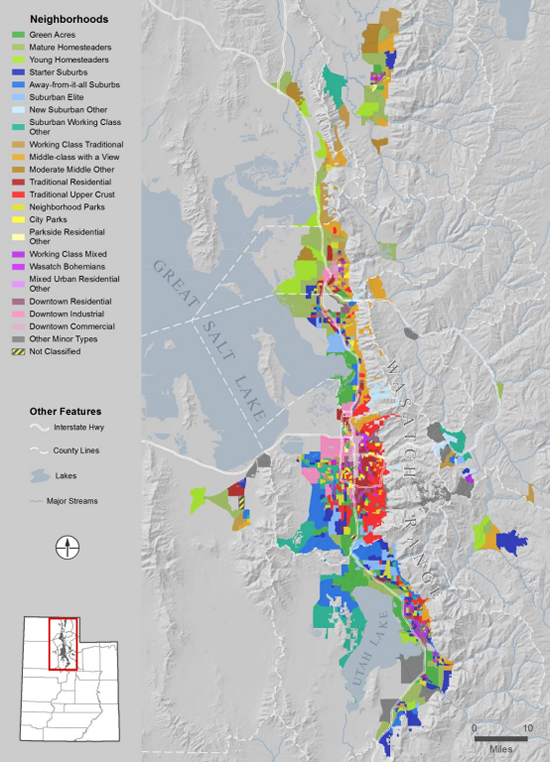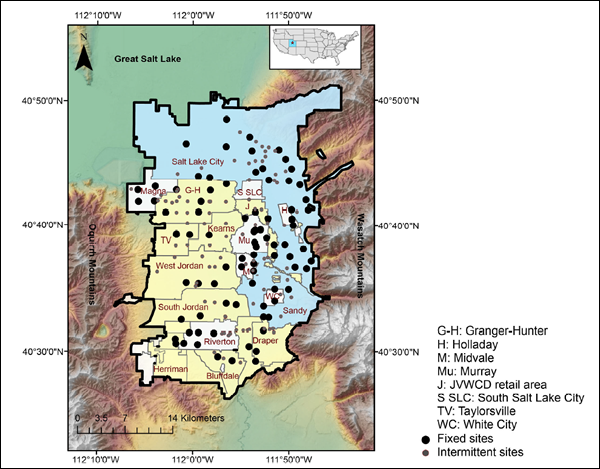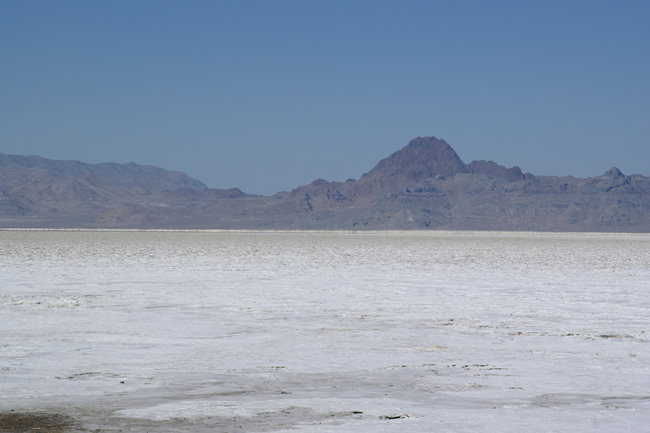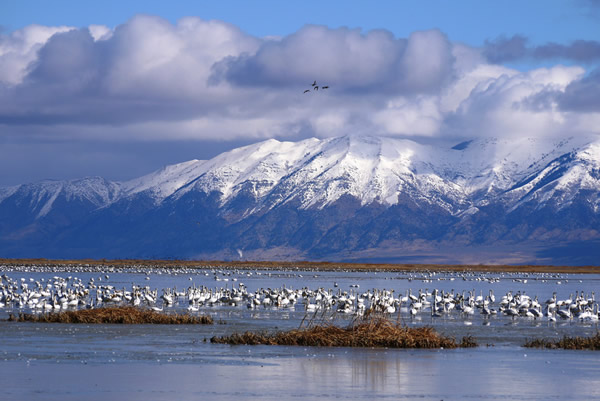News and Highlights
This is a list of past iUTAH EPSCoR news from 2012 to 2018.
November 2, 2016
iUTAH Researchers Publish Urban Typology Paper
In a recently published paper in the online journal, Cities and the Environment, iUTAH researchers examined the development of a multi-dimensional classification scheme that identifies distinct configurations of ‘urban forms’ in Northern Utah. The intent of the paper is to advance or answer the following research questions:
i. What measurable attributes of urban neighborhoods have been linked in the scientific literature to a range of water outcomes (demand, quality, and ecohydrology)?
ii. To what extent do urban neighborhoods reflect distinctive combinations of these measurable attributes?
iii. Are urban neighborhood types systematically associated with resident water attitudes and behaviors?
iv. How can a formal typology of urban neighborhoods be used to guide the scientific study and practical management of urban water systems?
While the examples and classifications are regional, the paper is directed at a methodology that relies on publically available data and can be used in other urban areas. Authors of the article include Douglas B. Jackson-Smith, Philip A. Stoker, Martin Buchert, Joanna Endter-Wada, Carlos V. Licon, Molly S. Cannon, Shujuan Li, Zack Bjerregaard, and Luke Bell.
The article can be viewed in its entirety under the title Differentiating Urban Forms: A Neighborhood Typology for Understanding Urban Water Systems.

October 27, 2016
New Publication Maps Salt Lake's Tap Water
iUTAH researchers Yusuf Jameel, a University of Utah graduate student, Geology and Geophysics professor Gabriel Bowen, and James Ehleringer, distinguished professor of biology, and colleagues sampled tap water throughout the Salt Lake Valley to see if stable isotopes of oxygen and hydrogen in the water could be used to study the various sources of water for the valley’s more than one million residents. The results of this study have been published in Water Resources Research.
A media release provided by the University of Utah’s science writer Paul Gabrielsen said, “The team found strong spatial patterns within the more than 800 tap water samples, indicative of how different sources of water are used in different parts of the valley. Isotopic signatures emphasized the importance of mountain snow to the valley’s water supply. The isotope signatures varied by season, reflecting the contribution of surface water. The team’s results show that isotopes of tap water can be used to study how water is used over a large urban area, offering new tools for effective management of a precious and limited resource.
As Utah’s population continues to grow, water managers and water scientists are looking more at water’s journey to our taps. Drinking water can come from a variety of sources, including lakes, streams and groundwater. Of those sources, mountain snow and spring runoff also play a significant role.”
Journal Reference: Water Resources Research

September 27, 2016
Comments Sought on Draft Utah Water Strategy
A draft of the state water strategy has been released to the public. When finalized, it will propose a 50-year water strategy to the governor’s office. This document, written by the State Water Strategy Advisory team’s chair, is now open for review and comment. Visit the Salt Lake Tribute article for an overview of the process to date.
iUTAH collaborator Joanna Endter-Wada, Professor of Natural Resource Policy and Social Science, participated on the team tasked with providing analysis and feedback. Other members of the team included water managers, climatologists, university researchers, elected officials, environmental activists, and others. Public comments are needed for the work facilitated by Envision Utah.
Please share this information through conversations, email, and social media. We encourage you to respond and make your voice heard. Comments can be submitted to Envision Utah’s website until Monday, October 24, 2016.

feedback on the draft Utah water strategy
September 14, 2016
Scientists Try To Solve The Puzzle Of The Shrinking Salt Flats Crust
iUTAH researcher Brenda Bowen, a University of Utah geoscientist, talked with reporter Judy Fahys on KUER radio about the research her team is doing to help solve the mystery of the shrinking crust at the Bonneville Salt Flats. The story says that research led by Bowen “is logging where the Lake Bonneville floor ends and where the layers of clay, gypsum and salt begin. Other data, like oxygen levels, is important too. The study is even looking at microbacteria. The researchers are exploring the reasons the salt crust is shrinking in breadth and depth.”
“We can look at that level of impact of what we’re doing,” says Bowen, “but we can also understand how is that relative to the scale of geologic change, of natural change, and ecological evolution even beyond what humans are doing.” Research, including data collection, on the salt flats is funded by a $1.5 million dollar grant from the National Science Foundation.

Photo credit: Hermann Luyken (Own work) [CC0], via Wikimedia Commons
September 6, 2016
A New Tool For Wetland Management
Utah State University researchers, including iUTAH researcher David Rosenberg, a professor in civil and environmental engineering, were recently featured in the news for contributions on the development of a model to improve arid-region wetlands.
The study was published in Water Resources Research on Sept. 1. Rosenberg, along with Omar Alminagorta, a former postdoctoral associate at the Utah Water Research Lab and USU Associate Professor Karin M. Kettenring, a wetland ecologist, co-authored the study. Findings show that if refuge managers implement the model's recommendations, they could nearly double the area of productive wetland habitat using existing resources." We found that more dynamically altering the water levels in wetland units at the refuge improves habitat for migratory birds," said Rosenberg.
In an excerpt from the EurekaAlert article “Rosenberg adds that adjusting water levels within wetland units more frequently also better corresponds to historical hydrologic conditions. The model also suggests focusing efforts to control invasive vegetation - particularly for phragmites, a widespread invasive grass - in late summer rather than early fall. These two changes, he explains, could significantly increase the habitat area for priority migratory bird species that use the refuge. ‘The model shows us how to better use scarce water, labor and financial resources to achieve the goals set by the refuge managers each year,’ said Rosenberg.”
Press: USU Today | EurekaAlert | ScienceDaily | Natural Science News | Utah Public Radio

Photo credit: Chris Luecke.
August 16, 2016
As a sustainability measure aimed at ensuring your data are available in the long term, all iUTAH datasets are being moved to a larger system called HydroShare for data publication. HydroShare is a new system developed by USU researchers, along with other partners. It includes the functionality of the current iUTAH Data Repository with some additional benefits:
· it supports formal publication of research products, including issuing citable digital object identifiers (DOIs)
· it supports collaborative groups with both public and private sharing of resources
· it supports sharing both data and models
Although there is some work involved in transitioning to HydroShare, the iUTAH Cyberinfrastructure Team is doing as much of this work as possible to ensure that any effort required of collaborators is minimal.
If you have submitted datasets to the iUTAH Data Repository: The iUTAH Cyberinfrastructure Team is handling the transfer of your datasets from the iUTAH Repository to the HydroShare system. In the next few weeks, we will contact you about your datasets. You can create a HydroShare account, and we will transfer ownership of the datasets to you. You can then edit and curate your datasets if needed (especially for those datasets that are currently private) and formally publish them. We will maintain pointers from the iUTAH Repository to HydroShare to redirect any potential users who have the old links.
If you have not yet submitted datasets to the iUTAH Data Repository: You can submit your datasets directly to HydroShare. We are preparing some instructions and a tutorial video for this process. You are welcome to submit datasets without that guidance or wait until the instructions are more complete.
Jeff Horsburgh, Amber Jones, and the iUTAH Cyberinfrastructure Team appreciate the work that many of you have done to add your datasets to the iUTAH Data Repository, and welcome you to contact them directly with questions about the transition.



